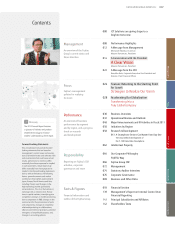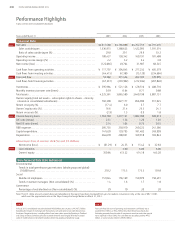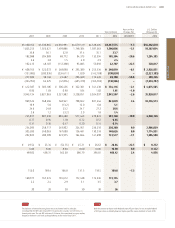Fujitsu 2012 Annual Report Download - page 19
Download and view the complete annual report
Please find page 19 of the 2012 Fujitsu annual report below. You can navigate through the pages in the report by either clicking on the pages listed below, or by using the keyword search tool below to find specific information within the annual report.
Future challenges and measures
After reviewing the results for fiscal 2011, what are some of the objectives and
urgent measures for the current term, fiscal 2012?
Fujitsu has designated fiscal 2012 as a “year to rekindle growth,” and is bolster-
ing capabilities in the three areas of sales interactions, system engineering (SE)
and technology. While rebuilding a solid business foundation, we aim to achieve
an operating income margin of 3%.
Q.2
A.2
Our fiscal 2012 targets are net sales of ¥4,550.0 billion, with operating income of ¥135.0 billion and an operating
income margin of 3%, representing both higher revenue and earnings. During fiscal 2011 we stated repeatedly that
we are shifting from a defensive to an offensive posture. Fiscal 2012 we have designated as a “year to rekindle
growth.” While maintaining our growth strategies of going on the offensive with structural reforms, accelerating
globalization, and creating new services businesses, we will seek to strengthen our corporate structure. Our target
operating income margin of 3% will serve as a milestone on the path to growth.
The business environment for ICT today is caught up in sweeping structural changes stemming from the current
wave of cloud services ? and big data ?. The extent to which we can continue to provide value to our customers and
lay out a path for business development will determine the true value of Fujitsu. As we reach this important junc-
ture, we recognize that we need to move away from our previous business model centered on system integration
(SI), and build a solid business foundation that can respond to this new era.
On April 1 we adopted a matrix-type organization structured along customer segments and business lines. This
was an offense-style structural reform intended to bolster capabilities in the three areas of sales interactions, SE
and technology. We also took further steps toward a
“fab-lite” business model to strengthen the business
structure for Device Solutions, including selling the Iwate
Plant to Denso Corporation.
Our medium-term goals are unchanged, and we will
continue to work steadily toward achieving our targets of
¥5,000 billion in net sales, with ¥250 billion in operat-
ing income and an operating income margin of 5%.
Looking ahead 5 to 10 years, we will reawaken the
“frontier spirit” that runs through our corporate DNA to
pioneer new markets, and exceed our current growth
trajectory to be a global company that stands alongside
the world’s leading firms.
?
Cloud Computing
At Fujitsu, cloud computing refers to a platform enabling on-demand
access via a network to IT resources (i.e., resources required to create
an adequate computer operating environment such as servers, stor-
age, networks, operating systems, and software) across the network.
Big Data
Yet to be definitively defined, big data does not simply refer to sheer
volume. Rather, it denotes huge volumes of a wide variety of data
that when processed in real time can be used to identify what users
were looking for at that time and place. “Unstructured data” that is
difficult to analyze such as image, voice, video, and sensor data
accounts for a considerable proportion of big data.
Glossary
User-side Provider-side
Datacenter
017
FUJITSU LIMITED ANNUAL REPORT 2012
Management
























